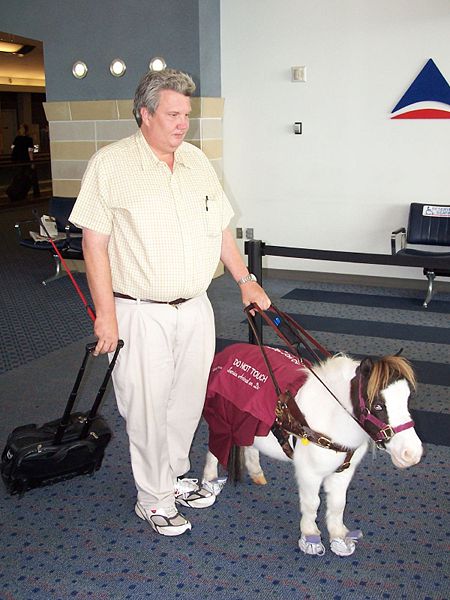Seeing Eye Mini-Horse

Guide dogs — sometimes referred to as seeing eye dogs — have been assisting disabled people for at least 100 years, with references to them dating back perhaps centuries. The first U.S. school for guide dog training, named The Seeing Eye, opened its doors in 1929 and has been in business since. (The colloquial use of the term “seeing eye dogs” is actually a reference to the school’s trademark and brand.) But not all people like dogs, and this includes some of the visually impaired and those with other disabilities which call for a service animal. So what other options are out there?
Meet the guide mini-horse.
Pictured above, the guide mini-horse acts much like its sibling service animal the guide dog. Much like the guide dogs, guide mini-horses act as trusted aides for those in need, helping them navigate through the world. And both take about a year to 18 months to train. But there are some major differences. The Guide Horse Foundation in North Carolina notes that guide horses are useful for about thirty years compared to around a dozen for dogs, making them arguably more cost effective over their useful lifespan. But there are downsides. The miniature horses need to live outside and require a lot more space than a guide dog, which can live in a small apartment without much difficulty. They also have the need to relieve themselves more often than dogs, making themselves much more cumbersome. And while they can be incredibly cute, this has its downside, as a guide animal isn’t supposed to be petted by others while on duty.
For some, however, a guide dog simply isn’t an option. The most likely scenario is due to an allergy to dog dander, but there are other reasons. Take, for example, the case of Mona Ramouni, a young Muslim woman in Michigan, reported by TODAY in the fall of 2010. Born blind, she was an excellent candidate for a guide dog — except that she came from a devout Muslim family. Dogs are considered unclean under Muslim law, and cannot be kept as pets — but horses can. Ms. Ramouni received Cali, guide mini-horse, and has since been able to navigate the world without help from friends and family — unless one counts Cali as a friend.
While guide horses may be a second choice after dogs, the demand for them has been, per the Guide Horse Foundation, “overwhelming.” As of this writing, the foundation has stopped taking applications for horses.
Bonus fact: On September 11, 2001, two guide dogs were in the World Trade Center with their owners when the buildings were attacked. The two dogs, named Salty and Roselle, successfully navigated an escape route for their owners. Both were given a Dickin Medal, given by the United Kingdom for “gallantry or devotion to duty while serving,” for their heroic acts.
From the Archives: Bat Man: A blind man who has taught himself to navigate the world using echolocation.
Related: A book about miniature horses.

Leave a comment